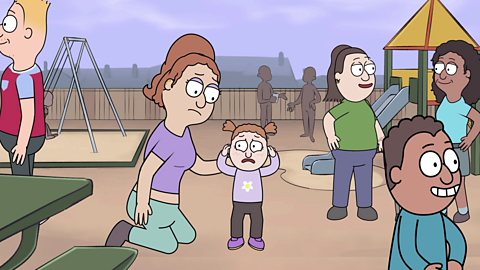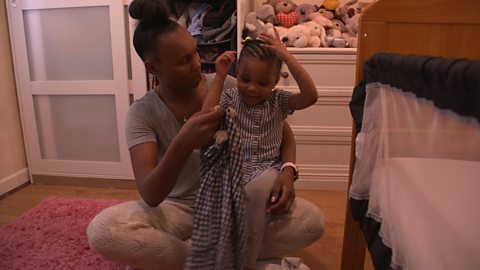Learning to dress themselves is a milestone in your childãs development but this daily routine can also become a fierce battleground.
ãWhen our daughter hit 2, she became fixated on dresses, tutus and anything pink. She had a physical aversion to anything else and began throwing clothes down the stairs when they didnãt fit the bill.ã Rachel, THP community
Sound familiar? Rest assured, youãre not alone. ãAll young children can find getting dressed difficult. Itãs a normal part of their development, and not just for those who are neurodivergent,ã explains .
ãThereãs a whole mix of factors behind it, some psychological, some developmental and some practical.ã

Why does my child have meltdowns about getting dressed?
Essentially, your child is trying to express their independence. ãThere are few areas in their lives where they have control and a say in what happens. But they can control certain things such as what they eat and what they wear,ã explains Daniel.
ãAnd although they want to be independent, they donãt always have all the skills to manage things like buttons and zips, so can get easily frustrated.ã
They may use this time to test your boundaries. ãAgain, itãs a healthy developmental stage. Youãre by their side as they get dressed, so they look for opportunities to keep you there. They see they can get your attention and their needs met by messing about and not complying.ã
Conflict can also come from the differences in what you prioritise, adds Daniel. ãYou might think about whatãs practical and appropriate. Whereas your child might consider whether their clothes are colourful or bright, and whether they feel or smell nice.ã
Fastenings and features like buttons, zips, pockets, seams and labels, and the fit of clothes bring extra sensory challenges, especially for children who are neurodivergent. ãSmell can be a factor too. For example, if you change your fabric softener to one with a different scent, it can be a huge change.ã
Then thereãs the process of getting dressed, adds Daniel. ãMornings are already rushed and stressful because you probably need to be out of the house at a set time. Getting dressed also indicates a transition ã you're likely to be leaving home to go somewhere. And transitions are also particularly difficult for children who are neurodivergent.ã
Five ways to manage conflict about clothes
First off, thereãs no one-size-fits-all strategy to tackle the tension. ãWhat works for one parent will not work for another. Itãs all about trial and error,ã says Daniel.
But recognising your child isnãt being deliberately manipulative, that itãs simply part of their development, can help you reframe whatãs happening. ãTake a step back and try to understand: ãWhat is my child trying to say and how can I help? What are they trying to communicate? Why is that resulting in a certain behaviour?ãã
ãWhen my daughter turned 2, she became really determined about clothes. It just took time, perseverance and accepting being late a lot to work through it. She sometimes looked hilarious, but I only ever stepped in if the outfit was not right for the weather, or she was literally exposing herself.ã Marie, THP community

1. Offer a simple choice
ãPut sensible limits on the time spent getting dressed. And limit their choices ã give them a choice of two items that are acceptable to you,ã recommends Daniel. ãThis way, they have some autonomy, but the overall message is: ãI'm still in control because I know what's bestã.ã
ãMy advice is to offer two options, or give them something to wear, explaining why, then let them choose another item like a coat, for example.ã Sara, THP community
2. Make simple swaps or adjustments
ãRemove labels if they cause discomfort or choose clothes where the labelling is printed on the fabric.
ãSocks with seams are a common dislike, so get seamless ones.
ãTry trousers or skirts with elasticated waistbands rather than buttoned ones.
ãIf your child finds underwear tight and restrictive, swap for looser boxer-short options.
ãAnd look out for sensory-friendly clothing ranges,ã recommends Daniel.
If your child has to wear specific clothes for an activity or a uniform, ask if reasonable adjustments can be made. ãFor example, if your child cannot tolerate a shirt collar, check if they can wear a softer polo shirt in the same colour,ã Daniel adds.
ãMy 5-year-old son has been fussy since he was about 3 ô§ and doesnãt like anything thatãs baggy. He insists on wearing jumpers two sizes too small to school, which he struggles to remove when heãs hot. Heãs now started wearing a fleece jacket as an alternative.ã Emma, THP community
3. Get organised
ãIf you can, get prepared the night before,ã recommends Daniel. ãAnd get your child into a routine of putting clothes on in a certain order. It gives consistency and security. Create a visual board that plots their daily routine including each step of getting dressed, so your child learns what's coming next.ã
ãI lay out shoes and socks by the door next to his nursery bag the night before, so theyãre the first thing he sees when he comes downstairs.ã Patrick, THP community
4. Involve your child (on your terms)
ãWith your child, make a list of clothes deemed acceptable,ã says Daniel. ãTry things out and ask them how they feel.ã
ãWhen it comes to buying new clothes, I involve him by selecting a few things I like and then he picks his favourites from these.ã Emma, THP community
5. Pick your battles
If your child is in full-on meltdown mode, talking things through often doesn't cut it, says Daniel. ãThe only thing you can do is allow emotions to come down. If that means allowing your child to wear what they want, just to get through, thatãs fine. You need to get the emotion out of the equation.ã
ãRemember, if you lose it, it does not make you a bad parent, it makes you a normal parent. When emotions have lessened, tell them that shouting is not something you want at home. Apologise if you have to, own it and say you made a mistake, and then move on.ã
ãGo easy on yourself. Rather than fight tooth and nail and ruin the day, sometimes itãs just easier to let them go out in the rain without wellies on and learn for themselves thatãs itãs not nice outside. Then have the wellies immediately to hand.ã Patrick, THP community






